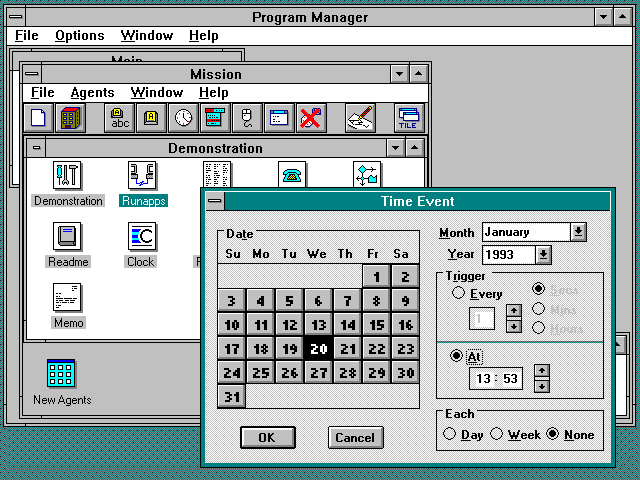| Publication Details: | |
|---|---|
| Publication: | “PC Plus”, UK |
| Issue: | |
| Date: |
| Product Information: | |
|---|---|
| Title: | Automator for Windows Version 1.3A |
| Author: | Direct Technologies Limited |
| Supplier: | Direct Technologies Limited |
| Phone: | (081) 847-1666 |
| Price at time of publication: | £149 |
| Fact Panel: | |
|---|---|
| Display Types: | Windows |
| Issue Disks: | 3.5″ 1.44Mb or 5.25″ 1.2Mb |
| Minimum Hardware: | 286/HD/2Mb/Mouse |
| Other Hardware: | n/a |

Brief Encounters: Automator for Windows
Automator for Windows, as its name implies, provides tools for automating tasks performed under Windows. It achieves this by means of ‘Agents’. Agents are intelligent user-defined macros, which can be executed either by a user action such as a mouse click, or triggered by a particular event such as a specified period of time elapsing. Agents can range from simple key-press recorders to sophisticated shells around Windows applications. All these features are only available while Automator is running: the features are easy to reach, but are equally easy to disable.
Installation is automatic and fuss-free. Once installed, Automator leaves the host system in a commendably ‘clean’ state, adding just one new program group and a small, clearly documented addition to WIN.INI. The only point to watch is that installation assumes the presence of Program Manager, so take care if you’re using an alternative Windows front-end.
Automator provides three new programs, namely Mission Control, Workshop, and Runtime. Runtime is provided to simplify execution of agents during debugging. Mission Control activates Automator . It looks a bit like Program Manager, in that it contains its own program groups, and provides controls for activating and suspending agents and setting up timed execution.
Workshop is the primary means of developing Automator agents. Agents are created as programs written in AWL, or Automator for Windows Language. Thankfully, Workshop can generate AWL code automatically, either by ‘learning’ user actions, or with the graphical dialogue editor. Many agents can be created entirely from auto-generated code without further modification. Workshop can make AWL code more readable, by adding comments and replacing numerical values with descriptive variables. AWL has similarities to C, Pascal and BASIC: features include multiple variable types, looping and conditional statements, and file-handling. Detection and control of Windows’ user interface are catered for, as is multi-tasking. AWL provides extensive events-handling facilities for keyboard and mouse activity, display feature detection, and time triggers. Security is addressed by ‘password’ text-entry boxes, where the box displays only asterisks, and the ability of agents to disable the keyboard and mouse.
Documentation consists of two spiral-bound A5 manuals. The User Guide contains an introduction and tutorials on Automator’s features, and the Developer Guide provides a full command-reference for AWL. Both manuals are clear and concise, with liberal use of screen-shots to illustrate specific points.
Automator for Windows is an excellent candidate for a Windows batch programming language, being simple for novices to use, yet smart enough for corporate environments. The unobtrusive way in which it provides sophisticated facilities in particular merits applause. This well-designed package deserves to do well.
Tim Baty
Verdict:
For:
- Well-designed development tools
- Powerful programming language
- Unobtrusive installation
Against:
- Requires Program Manager for installation
| Score-Card: | |
|---|---|
| Range of features: | * * * * * |
| Overall Speed: | * * * * |
| Ease of Use: | * * * * * |
| Documentation: | * * * * |
| PC Plus Value Verdict: | * * * * * |